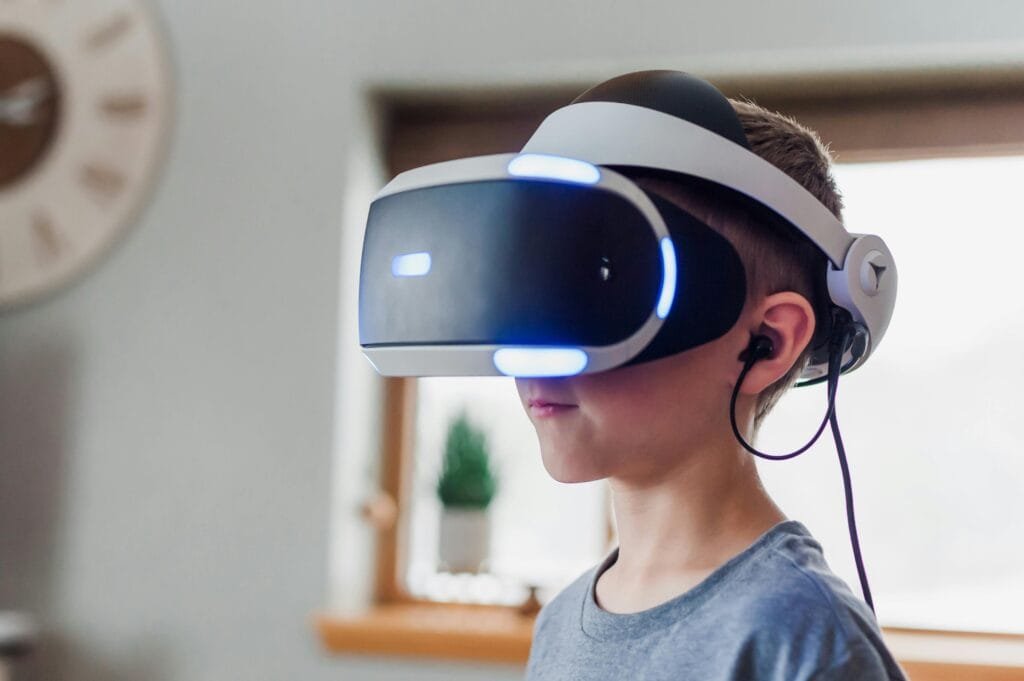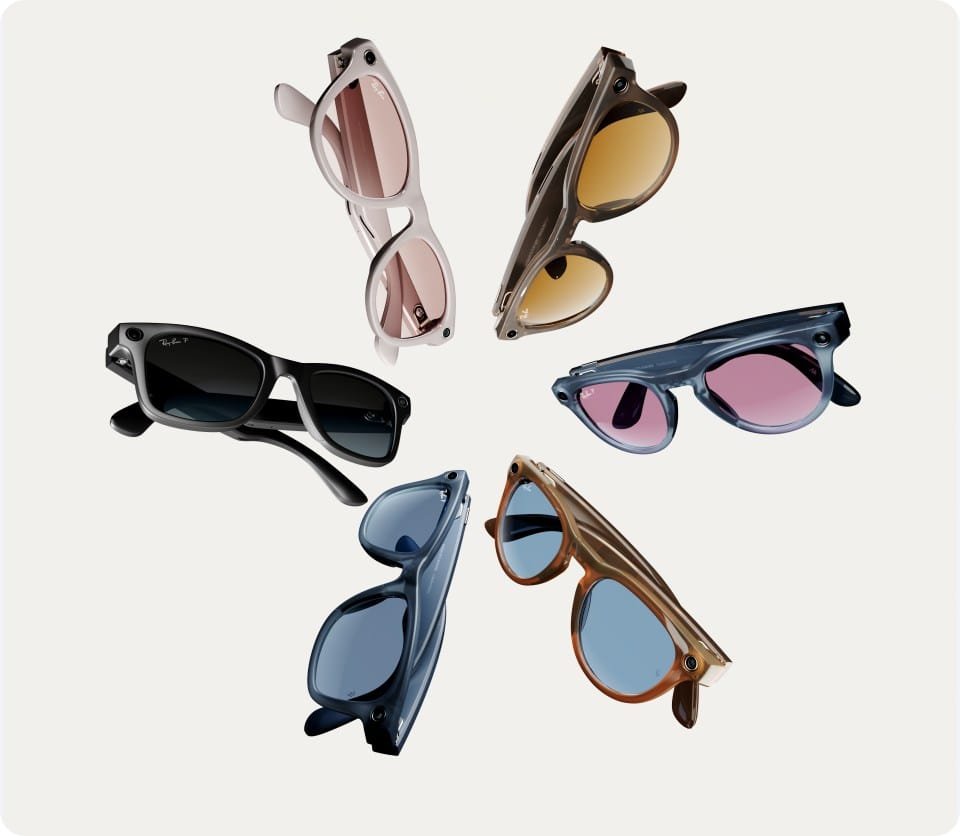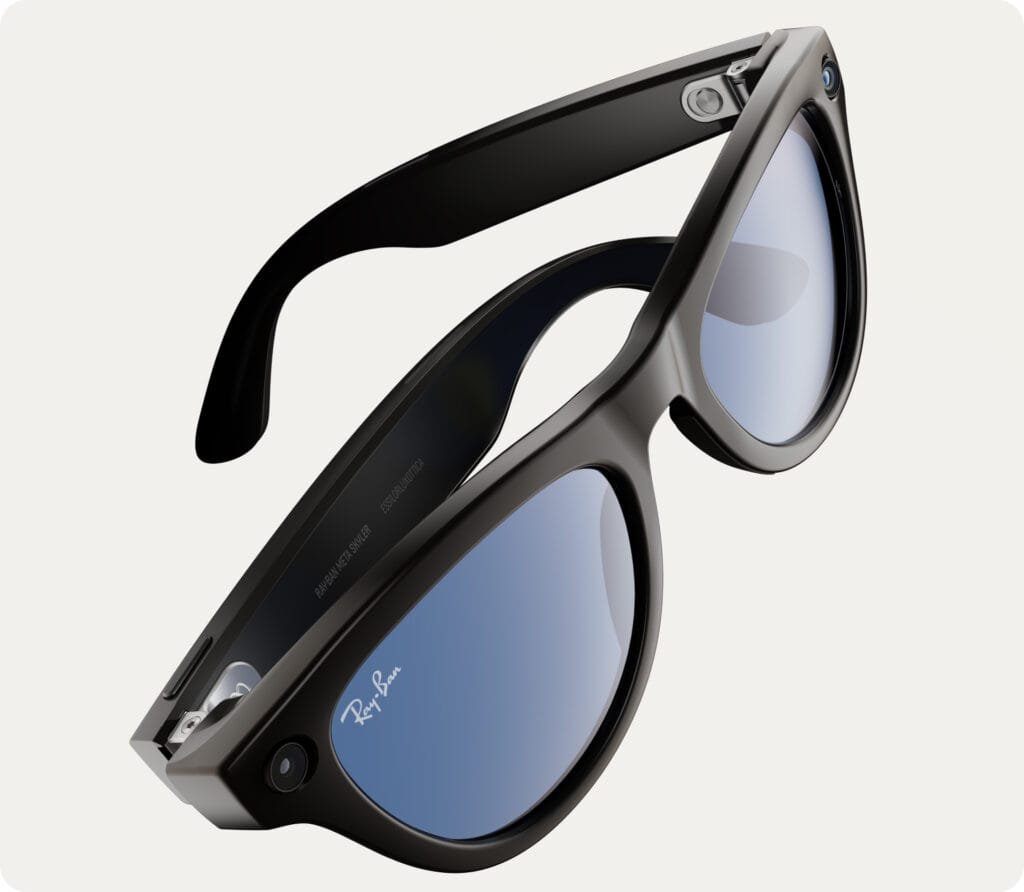Meta smart glasses embody the exciting potential of wearable technology to seamlessly integrate our virtual and physical worlds.
The Meta smart glasses are also a pit stop in the evolution of wearable technology. You will be surprised to know that the idea of integrating AR (Augmented Reality) into glasses began in the early 1980s. Pioneers such as Steve Mann and companies like Xybernaut made attempts to add digital interfaces to glasses. However, these smart glasses were not yet mainstream. Google made them mainstream when it unveiled the Google Glass in 2013. These glasses were revolutionary at the time of their launch. But, they had major challenges in design, functionality, privacy concerns, and consumer acceptance.
In the 2010s, there was a rise in interest in AR and virtual reality (VR). This laid the groundwork for the next generation of smart glasses. Meta (formerly Facebook) has taken the smart glass capabilities to the next level. It aims to provide not just an upgrade in technology but also enhance the experience of daily activities.
What’s Inside?
Evolution of Meta Smart Glasses: Fashion Meets Function

The journey of Meta smart glasses began a decade ago, in 2014. At that time, Meta was Facebook, and it acquired Oculus VR for approximately $2 billion. This acquisition marked Meta’s entry into virtual and augmented reality. It also hinted at Meta’s ambitions to create an immersive digital layer that would work seamlessly in the physical world.
Initial Product Launch: Ray-Ban Stories (2021)
Meta launched Ray-Ban Stories in collaboration with Essilor Luxottica (the parent company of Ray-Ban). These smart glasses seamlessly combine technology into everyday eyewear. The key features of Ray-Ban Stories (2021) were –
1. Dual 5MP Cameras to capture photos and videos from a first-person perspective.
2. Hands-Free Experience with voice commands to use the smart glasses without needing to interact with the smartphone.
3. Audio integration through built-in speakers for listening to music or attending calls.
Transition to Meta Quest: Enhanced Features and Functionality
After the launch of Ray-Ban Stories, Meta shifted its focus towards the creation of advanced smart glasses. In October 2021, the company unveiled Meta Quest (formerly Oculus Quest). It represented Meta’s vision for more immersive AR experiences. Meta Quest was primarily a VR headset. However, it represented the potential of AR integration into smart glasses and into the Meta ecosystem.
The Meta Smart Glasses (2023)
In 2023, Meta released its next generation of smart glasses. These glasses were built upon the foundation of Ray-Ban stories. These glasses had –
1. Augmented Reality Capabilities: Meta’s smart glasses integrated AR overlays. This integration allowed the users to superimpose the digital information on the physical world.
2. Enhanced Interaction: Meta-improved voice recognition and gesture controls to ensure a more intuitive and responsive user experience.
3. Integration with Meta’s Ecosystem: The Meta smart glasses are designed to seamlessly connect with Meta’s suite of apps and services. So, the users can access social media, navigation, and communication tools in real-time.
Key Features of Meta Smart Glasses

Augmented Reality Integration
One of the main features of Meta smart glasses is AR integration, which allows users to overlay digital information onto their real-world surroundings. This technology is at the core of Meta’s long-term vision, making everyday tasks easier, more interactive, and immersive. With AR, users can get directions, receive notifications, or play AR games, all while staying connected to the physical world.
Voice Control
Meta’s smart glasses come equipped with voice control, giving users hands-free access to their smart glasses’ features. This feature is powered by Meta’s own voice assistant, which allows users to take photos, send messages, play music, or make phone calls, all with simple voice commands.
Camera and Video Recording
A built-in camera allows users to capture high-quality photos and videos on the go. This feature is particularly useful for capturing moments in real time without needing to reach for a smartphone. The hands-free, first-person perspective provides a new way to document life as it happens.
Audio Capabilities
Meta smart glasses are also equipped with built-in speakers that allow users to listen to music, take calls, and hear notifications without the need for earphones. The open-ear design ensures that users remain aware of their surroundings, while directional audio provides a personal listening experience without disturbing those nearby.
Seamless Connectivity
These smart glasses are seamlessly integrated with smartphones and other devices, allowing notifications, calls, and other data to be synced in real time. Users can pair their glasses with their Meta app, where they can manage settings, access media, and customize the user experience.
Latest Developments in Meta Smart Glasses

Meta smart glasses are creating a foundation for the future of wearable technology. An AR-integrated future that can make smart glasses ubiquitous. Meta does not stop at just photo and video capture or notification. The company is doing the groundwork for creating fully immersive digital layers. Recent developments in the meta smart glasses include:
AR Ecosystem Expansion
Meta smart glasses are developed with a robust AR ecosystem in mind. This ecosystem includes the integration of applications for education, navigation, and entertainment. For example, users can see real-time translations displayed directly in their line of sight. These educational overlays can also provide info on landmarks or historical sites through your glasses.
Ray-Ban Stories
The launch of Ray-Ban Stories is an exciting collaboration between Meta and Ray-Ban. So, now Meta offers a stylish pair of smart glasses that combine tech functionality with fashion appeal. These glasses will appeal to users who want a more subtle option in wearable technology. It focuses on ease of use and style to ensure optimum daily utility. Ray-Ban stories help Meta to target a broader consumer market of fashion-conscious individuals.
Meta’s AR Glasses Roadmap
AR or Augmented Reality is the future. Acknowledging this, Meta has developed a roadmap for AR integration in its Meta smart glasses. The company plans to offer more advanced models in the coming years. The future iterations promise to integrate AR, improve battery life, and enhance immersive experiences. This step moves Meta closer to its vision of a fully digital layer over the physical world.
Enhanced Privacy Features
Privacy concerns have always plagued smart glasses. So, Meta smart glasses have taken steps to ensure robust privacy features. Meta now includes visual indicators that show when the camera of the smart glasses is under use. Meta also promises better data encryption and customization of privacy settings. This step gives users greater control over the collection and sharing of their data.
Partnerships with Developers and Brands
Meta is partnering with other developers and brands. The goal is to create custom apps and experiences to expand the functionality of the meta smart glasses. So, in the future, users can access exclusive AR games, virtual shopping experiences, and tailored services based on their preferences.
A Comparison of Meta Smart Glasses with Other Smart Glasses in the Market
Feature | |||||
Display Technology | No display | No display | Waveguide optics | Prism projection | No display |
Voice Control | Yes (Facebook Assistant) | Yes (Siri, Google Assistant) | Yes (Alexa, Google Assistant) | Yes (Google Assistant) | Yes (Alexa) |
Camera | Dual 5MP cameras | No camera | 8MP camera with 1080p video | 8MP camera, 1080p video | No camera |
Speaker/Audio | Open-ear speakers | Open-ear speakers | Noise-cancelling speakers | Bone conduction | Open-ear speakers |
Microphone | 3-mic array | Mic for voice calls | Built-in microphone | Built-in microphone | Beamforming mic array |
Battery Life | 6 hours playback | 3.5 hours playback | 4 hours display use | 8 hours (usage-dependent) | 14 hours (intermittent use) |
Weight | 50g | 45g | 90g | 46g | 31g |
AR/VR Capabilities | No | No | AR (limited) | No (focused on business apps) | No |
Prescription Lenses | Yes | Yes | Yes | Yes | Yes |
Water Resistance | IPX4 (splash resistant) | IPX2 (sweat resistant) | No rating | IP53 (dust/splash resistant) | IPX4 (splash resistant) |
Charging Method | Proprietary charging case | USB-C | USB-C | USB-C | Proprietary charging port |
Use Case | Social media sharing, calls | Music, calls | Augmented reality, enterprise | Enterprise/business applications | Voice assistant, notifications |
Price Range (INR) | ₹24,900 – ₹31,600 | ₹16,500 – ₹20,600 | ₹66,000 | ₹82,500 | ₹20,600 |
6 Challenges and Future Prospects of Meta Smart Glasses

Meta smart glasses are definitely a major step in wearable technology. However, mass adoption still remains a distant goal. Meta has to address several challenges and limitations that affect user experience. The company does offer an exciting combination of features and design. However, certain limitations continue to adversely affect user experience. Solving these hurdles is the key to ensure that the smart glasses can achieve their full potential.
Here are the 6 key challenges that Meta smart glasses need to address –
Battery Life of Meta Smart Glasses
Battery life continues to be the most urgent challenge for the developers of smart glasses. The smartwatches have to fit powerful hardware, sensors, and connectivity features into a small, lightweight frame.
The developers have to balance the power consumption with practicality. Meta’s smart glasses can only offer a few continuous hours of use before you have to recharge them. So, their utility for extended daily use is severely limited. Moreover, some users want to use smart features such as voice commands, video recording, and music playback. This requires inconvenient and frequent recharges.
So, the primary focus of meta smart glasses is to improve battery life without compromising on compact form. Research is ongoing for energy-efficient chips and better battery management systems. The developers are also exploring alternative power sources, such as solar charging and kinetic energy. These innovations are aimed at extending battery life to reduce the need for frequent recharges.
Meta Smart Glasses and Privacy Concerns
Privacy concerns are a major obstacle for many people when it comes to smart glass adoption. The idea of smart glasses is to have a hands-free device to take photos, record videos, and do live streams. This is a very appealing idea. But, these possibilities also raise concerns about the misuse of this technology. For example, people are worried about someone capturing their video in public without their consent. This fear was widely expressed at the launch of Google Glass.
Meta smart glasses have implemented features to address privacy concerns. These glasses contain a visible LED indicator that lights up when the glasses are recording. Moreover, the company assures the users that they can manage their data with enhanced privacy settings and controls. Users still have valid concerns over how their personal information is collected, stored, and shared. The company’s past reputation, specifically Facebook’s controversies with data handling, has definitely added a layer of scepticism.
So, building consumer trust in data privacy and security has to be a major agenda for meta smart glasses. Companies have to balance the ethical implications of always wearable tech with the convenience of use. It is crucial to address concerns about responsible data use as the technology of smart glasses evolves.
Price Point of the Meta Smart Glasses
The high price point of the meta smart glasses definitely acts as a barrier to their adoption by the masses. The early adopters and tech enthusiasts will no doubt be willing to invest early. But, if the smart glasses have to go mainstream, the price range has to become more accessible.
Meta’s Ray-Ban Stories specifically come with a premium price tag. So, they are not so appealing to casual users. These users might not see the value of investing in smart glasses. They already have smartphones and smartwatches that offer them similar functionality.
If Meta smart glasses want to broaden their appeal, Meta has to introduce more affordable models. Offering smart glasses with fewer features or targeting diverse consumer segments might be a way forward.
Smartphones also had a similar challenge over a decade ago. As the production costs decreased and the technology became more efficient, this challenge was addressed. We saw a wide range of smartphones at varying price points. A similar turn of events is a possibility for smart glasses. But, as of now, the price point definitely stands in the way of the appeal of meta smart glasses.
Meta Smart Glasses – the Challenges of User Experience and Interface
Another key challenge for the meta smart glasses is creating an intuitive and seamless user interface. Meta has definitely made strides in simplifying the interface by adding voice commands and easy-touch controls. Still, the learning curve for new users is steep when it comes to Mets smart glasses.
The combination of physical gestures, voice prompts, and app-based controls makes navigation challenging. But, the user has to master this mix to enjoy the full functionality of the smart glasses. So, the challenge for meta is to make these interactions feel natural and distraction-free.
We can expect that the future iterations of the meta smart glasses will focus on refining their user interface. There is a possibility of incorporating eye-tracking technology and brain-computer interfaces. These additions have the potential for more seamless control over the glasses. Users will definitely appreciate the practicality of the more fluid and immersive interface.

Augmented Reality (AR) Integration in Meta Smart Glasses
Integration of augmented reality (AR) is the next big leap in the evolution of smart glasses. As of now, Meta smart glasses (Ray-Ban stories) do not have full AR functionality as of now. However, the company has tied the integration of AR capabilities to its broader vision – the development of the metaverse.
The metaverse is the digital ecosystem where meta envisions the convergence of virtual and physical worlds. Meta company expects its AR-powered meta smart glasses to play a key role in this vision. Meta’s users are to interact with the digital overlays in the real world, enabled by the meta smart glasses. These smart glasses will be the tools for work, social interactions, and entertainment.
Social Acceptance of Meta Smart Glasses and Cultural Shift
The final challenge for the meta glasses is not a simple one. It is the challenge of social acceptance. A Large section of the population has embraced smartphones and smartwatches. They have become socially normalized and ubiquitous so that the users don’t really stand out as an anomaly.
Meta has definitely tried to make their meta smart glasses more stylish and approachable by collaborating with Ray-Ban. However, the cultural shift that will encourage people to fully embrace the meta smart glasses in their everyday lives has not yet happened. This slow adoption has multiple causes, such as privacy concerns and general unfamiliarity with the novelty of smart glasses.
Meta smart glasses have to drive social adoption through product design and cultural engagement. They have to convince the larger public about the usefulness and necessity of this new piece of technology. One could compare this process to how smartphones were once considered a luxury. Now, they are a necessity. This transition is going to be gradual. However, smart glasses do have the potential to follow a trajectory similar to that of smartphones.
The Future of Meta Smart Glasses
Meta smart glasses aim to create a world where smart glasses are as essential as smartphones. They are set to revolutionize how we navigate our virtual and physical worlds. Continuous improvements in AR technology, hardware, and user experience are also adding to the excitement of the users.
The launch of Meta smart glasses hints at Meta’s broader ambitions towards Augmented Reality. At the same time, the present versions don’t yet have full AR capabilities. But, it is clear that Meta is laying the groundwork for a future where its smart glasses seamlessly integrate the virtual world with the physical world. The Meta smart glasses are going to be the gateway to the immersive Metaverse and become an integral part of our daily lives.


